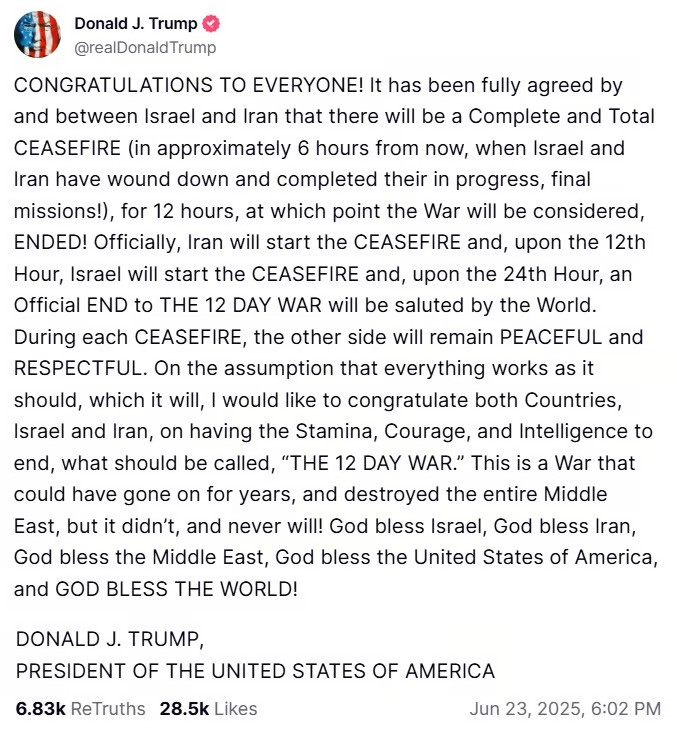A "Complete and Lasting Ceasefire" Between "Iran and Israel," Trump declared end of the "12-Day War."
Input
Modified
U.S. Military Intervention Created a Decisive Turning Point Ceasefire Took Effect on June 24, 24 Hours After the Announcement Both Sides Must Maintain Mutual Respect During the Ceasefire Period

Iran and Israel have reached a sudden ceasefire agreement through mediation by the United States, Qatar, and other key Middle Eastern nations. The war, which began 12 days ago with Israel’s airstrike on Iran, has now come to an end. Analysts say that the U.S.’s swift military intervention played a decisive role in preventing a full-scale war by weakening Iran’s will to retaliate.
However, concerns remain that tensions could flare up again at any time, given unresolved structural conflicts in the region, such as Iran’s potential resumption of nuclear development, shifting positions among Sunni Arab states, continued activity by proxy forces like the Houthi rebels, and the challenges of rebuilding Gaza.
Iran and Israel Effectively Agree to Ceasefire
On June 22 (local time), U.S. President Donald Trump announced via his social media platform Truth Social around 6 p.m. Eastern Time that “Israel and Iran have agreed to implement a complete and total ceasefire,” adding that “the war will officially end 24 hours from now.” He further explained, “The ceasefire will begin six hours after both sides complete their current final operations and withdraw. Iran will initiate the ceasefire, and 12 hours later, Israel will follow.”
Trump designated June 24—the scheduled start date of the ceasefire—as the reference point to define the active duration of the conflict, which he termed the “12-Day War.” He stated, “During the ceasefire period, both sides must maintain mutual respect,” and continued, “Assuming everything proceeds as planned, we celebrate the persistence, courage, and wisdom that brought this war to an end.” He emphasized, “This war could have lasted for years and devastated the entire Middle East—but that didn’t happen, and it never will.”
According to Reuters, the Iranian government initially issued an official denial shortly after Trump’s announcement, saying “no ceasefire agreement exists.” However, Iranian Foreign Minister Abbas Araghchi acknowledged that “if Israel halts its bombings, Iran will also stop its attacks,” effectively signaling agreement to a mutual cessation of hostilities. Israel did not release an official statement, which observers interpreted as a tacit acceptance of the mediated terms.
Meanwhile, Vice President J.D. Vance credited President Trump with securing the ceasefire, declaring, “In the future, the world will look back on America’s strike on Iran’s nuclear facilities as a pivotal reset moment for the Middle East.”

Qatar and Other Middle Eastern Nations Drive Diplomatic Push
The latest armed conflict began on the 12th, when Israel launched a surprise airstrike on Iran’s nuclear facilities and military bases. Framing the attack as a preemptive measure to stop Iran’s nuclear weapons program and military threats, Israel targeted key sites in Natanz, Isfahan, and Tehran, resulting in the deaths of several high-ranking figures, including Iran’s Chief of Staff, the commander of the Islamic Revolutionary Guard Corps, and leading nuclear scientists.
Eighteen hours later, Iran retaliated with a massive ballistic missile strike under “Operation Promise III,” triggering a cycle of reciprocal missile and drone attacks between the two nations.
Amid escalating tensions, the United States' full-scale military intervention marked a decisive turning point in the region. Initially, President Trump appeared to favor diplomacy, stating he could make a military decision “within two weeks.” However, his actions came much sooner than anticipated. On June 21, shortly after warning that Iran would face “a more forceful response” if it failed to pursue peace, the U.S. military launched precision strikes using B-2 stealth bombers and nuclear-powered submarines on three Iranian nuclear sites: Natanz, Isfahan, and Fordow—abandoning the two-week timeline for immediate, decisive action.
Two days later, on June 23, Iran launched 14 ballistic missiles at the U.S. Al Udeid Air Base in Qatar as a limited retaliatory measure. However, because Iran had informed Qatar in advance, the damage was minimized: 13 of the missiles were intercepted, and no casualties were reported. Analysts widely interpreted the attack as symbolic, aimed more at saving face than inflicting harm. President Trump quickly commented, “Iran responded far more weakly than we expected.” He further added, "Now we can move toward peace." He also emphasized that Israel should show restraint and commit to a peaceful resolution.
Following Iran’s pullback in the face of overwhelming U.S. pressure, active mediation by Middle Eastern countries played a pivotal role in securing the ceasefire. According to Reuters, on June 23, Qatari Prime Minister and Foreign Minister Sheikh Mohammed Al Thani held direct phone calls with Iranian officials to urge acceptance of the U.S.-backed ceasefire proposal.
In addition, foreign ministers from 20 countries—including Saudi Arabia, Oman, the UAE, Jordan, and Egypt—issued a joint statement calling for an end to Israeli hostilities, the establishment of peace, and renewed U.S.-Iran diplomatic engagement.
Speculation Over Regime Change in Iran Emerges
With direct hostilities between Iran and Israel entering a lull, international attention has now shifted to the post-ceasefire dynamics in the Middle East. Among analysts, some are beginning to raise the possibility of regime change in Iran.
On June 22, President Trump posted on Truth Social, “The term ‘regime change’ may not be politically correct, but if the current Iranian regime cannot make Iran great again, there’s no reason not to change it.” He ended the post with the phrase “MIGA – Make Iran Great Again,” suggesting that a regime change could be justified if living conditions for the Iranian people do not improve.
Israeli Prime Minister Benjamin Netanyahu echoed similar sentiments during an interview with Fox News conducted during the conflict. Asked whether regime change in Iran was part of the military operation’s objective, Netanyahu responded: “We are prepared to do everything to eliminate the nuclear and missile threat.” He further noted, “Given how vulnerable the Iranian regime is, regime change is certainly a possible outcome.”
After Israel’s airstrikes, Netanyahu also remarked, “The Iranian people must rise against their evil regime.” Many analysts speculate that this is Israel's open call for internal resistance in Iran.
Observers warn that despite the ceasefire, the region has entered a phase of unstable equilibrium, where the surface calm masks underlying and unresolved tensions. Though Iran and Israel, under international pressure, opted for pragmatic restraint and avoided full-scale war, structural fault lines remain.
These include Iran’s potential resumption of nuclear development, the ongoing activity of proxy groups like the Houthis, the reconstruction of Gaza, and the enduring conflict between Israel and Palestine.
Additional factors, such as shifts in U.S. Middle East policy and the deepening of diplomatic ties between Gulf Sunni states and global powers like Russia and China, are likely to shape future regional dynamics.





















